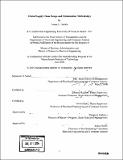Global supply chain design and optimization methodology
Author(s)
Henkle, Aimee L. (Aimee Leigh), 1975-
DownloadFull printable version (10.24Mb)
Other Contributors
Leaders for Manufacturing Program.
Advisor
Thomas Roemer and Alvin Drake.
Terms of use
Metadata
Show full item recordAbstract
The work for this thesis was performed at Honeywell in the Automation and Control Solutions (ACS) division. The project focuses on ACS's manufacturing strategy regarding its global supply chain design, primarily discussing the manufacturing growth opportunities available in emerging regions. Honeywell ACS's current methodology for the development of a long-term manufacturing strategy is based on growth and total cost reduction objectives. In order to comprehend the total cost of the manufacturing strategy, considerations such as inventory, logistics and duties, outsourcing and material sourcing are evaluated. The project also considers a factory's geographical location and ACS's year-by-year implementation plan. An outcome of this Honeywell project and the basis of this thesis is the development of a general supply chain design and optimization methodology that utilizes three analytical tools (Country Selection Framework, Total Cost Model and Implementation Plan Process) that are capable of validating the supply chain design of any company. The analytical tools can be used to verify key strategic supply chain decisions or to create a baseline manufacturing strategy. The following results can be determined using this supply chain design methodology: Determine an appropriate operating region for current or future business needs; Evaluate the feasibility of factory relocation projects by considering all relevant costs; Evaluate the cost implications of the supply chain structure by considering logistics, inventory and material sourcing costs; Understand the impact of outsourcing on the manufacturing strategy; Recommend a year-by-year implementation plan in the case of multiple projects and limited capital resources.
Description
Thesis (M.B.A.)--Massachusetts Institute of Technology, Sloan School of Management; and, (S.M.)--Massachusetts Institute of Technology, Dept. of Electrical Engineering and Computer Science; in conjunction with the Leaders for Manufacturing Program at MIT, 2004. Includes bibliographical references (p. 72).
Date issued
2004Department
Leaders for Manufacturing Program at MIT; Massachusetts Institute of Technology. Department of Electrical Engineering and Computer Science; Sloan School of ManagementPublisher
Massachusetts Institute of Technology
Keywords
Sloan School of Management., Electrical Engineering and Computer Science., Leaders for Manufacturing Program.